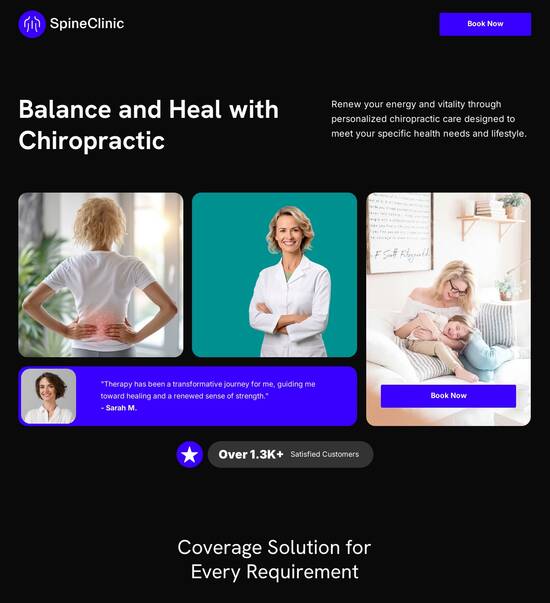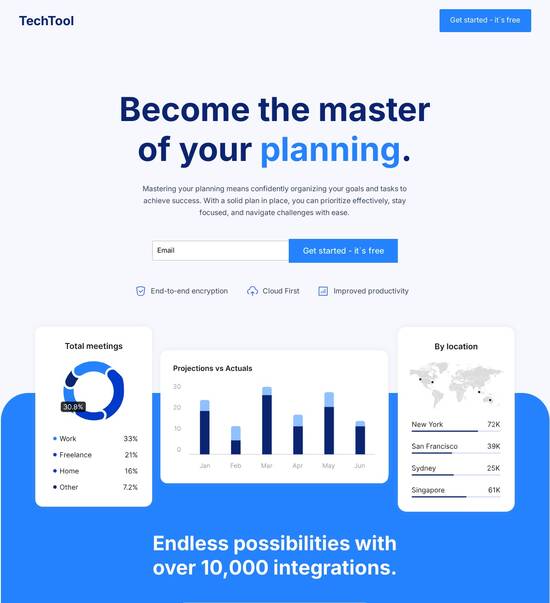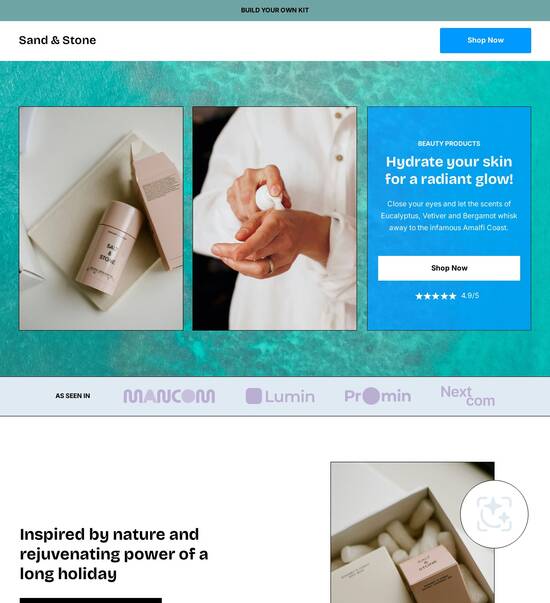
Material design notifications page template
Explore Similar TemplatesAbout template
Unleash your creativity with the material design notifications page template. Try Instapage today.
Recommended templates

Easy to build without coding
With the intuitive drag-and-drop builder, anyone on your team can create high-converting pages without any knowledge of code or design. Make enhancements to your landing page with custom widgets using Javascript, HTML/CSS, or third-party scripts.

Multiple layouts for any industry and goal
Select from 500+ landing page layouts built to boost conversions across industry-specific scenarios. Customize them by adjusting fonts, adding images, and generating on-brand content with the AI assistant. Quickly scale with Instablocks® and Global Blocks that you can save, reuse, and update globally.

Loads fast and looks polished on any device
Every template is responsive, which means they present professionally on any device and load blazingly fast with our Thor Render Engine. You can also power them up with Google AMP technology to deliver an unparalleled mobile experience and drive higher conversions.

Robust analytics & experimentation
Get real-time updates and reporting across all your devices, showing the number of visitors, conversions, cost-per-visitor, and cost-per-lead. Launch AI-powered experiments, run A/B tests, and use heatmaps to analyze user behavior, then optimize your landing page to maximize conversions.







Easy to build without coding
With the intuitive drag-and-drop builder, anyone on your team can create high-converting pages without any knowledge of code or design. Make enhancements to your landing page with custom widgets using Javascript, HTML/CSS, or third-party scripts.
Multiple layouts for any industry and goal
Select from 500+ landing page layouts built to boost conversions across industry-specific scenarios. Customize them by adjusting fonts, adding images, and generating on-brand content with the AI assistant. Quickly scale with Instablocks® and Global Blocks that you can save, reuse, and update globally.
Loads fast and looks polished on any device
Every template is responsive, which means they present professionally on any device and load blazingly fast with our Thor Render Engine.
Robust analytics & experimentation
Get real-time updates and reporting across all your devices, showing the number of visitors, conversions, cost-per-visitor, and cost-per-lead. Launch AI-powered experiments, run A/B tests, and use heatmaps to analyze user behavior, then optimize your landing page to maximize conversions.
All the features you need to build lead-generating landing pages
Explore more featuresLearn how to build top-performing landing pages for any goal
FAQs
Leading the way in building high-performing landing pages





An Effective Guide to Transforming Your Campaigns with Instapage's Landing Pages
Creating high-converting landing pages is essential for marketers aiming to maximize ROI on their campaigns. Instapage offers a robust landing page and CRO platform that allows you to optimize your digital marketing initiatives seamlessly. With an array of features that cater to marketers in diverse sectors, including tech, education, finance, and government, Instapage makes launching effective campaigns easy and efficient.
Understanding Landing Page Optimization
Landing page optimization involves various strategies and tools designed to enhance user experience, drive traffic, and improve conversion rates. Instapage enables marketers to create targeted landing pages that resonate with user intent. By leveraging A/B testing, heatmaps, and analytics, your team can identify which elements work best.
- A/B testing: Test different versions of your landing page to see which performs better in terms of conversion.
- Heatmaps: Analyze user behavior to understand how visitors interact with your page.
- Analytics dashboard: Use performance metrics to assess and refine your strategy continuously.
Step 1: Crafting Compelling Landing Pages
Utilizing Instapage's extensive library of high-converting templates is key to crafting effective landing pages. Here's how you can get started:
- Choose a template: Select from over 100 customizable templates tailored for different industries.
- Utilize Instablocks: Leverage reusable blocks of content to ensure consistency and speed in page creation.
- Incorporate lead generation tools: Use forms and CTA buttons that are strategically placed to encourage conversions.
Step 2: Optimize for Target Audiences
Creating personalized experiences is crucial for increasing engagement. Instapage provides tools for audience segmentation and dynamic content delivery.
- Dynamic text replacement: Personalize content to match the visitor's search term.
- AdMaps: Align specific ads with dedicated landing pages to ensure continuity and relevance.
- Audience metrics: Track performance to tailor content and strategies for different audiencesegments.
Step 3: Collaborate for Faster Results
Collaboration is vital in streamlining landing page production. Instapage facilitates real-time editing and feedback.
- Feedback loops: Quickly share your page with collaborators for instant reviews.
- Real-time edits: Make live changes that can be immediately viewed by your team.
- Stakeholder sharing: Securely share landing pages with external reviewers for greater input.
By integrating these steps, marketers can dramatically improve the effectiveness of their landing pages, fostering a significant increase in conversions and customer satisfaction.
Ready to elevate your marketing strategy? Start using Instapage today to create landing pages that convert.
People also ask about Material design notifications page template
Exploring Material Design Notifications Page Template: Elevating User Engagement
Understanding material design principles
Material Design is a design language developed by Google, emphasizing the importance of intuitive and beautiful interfaces. This design philosophy is characterized by a focus on bold colors, typography, and responsive animations, crafting an immersive user experience. Essentially, Material Design aims to make digital interaction feel more human and tangible, mimicking the physical world through its use of layers, depth, and motion. In the realm of applications, understanding and implementing Material Design principles can significantly enhance user interfaces, creating seamless and engaging interactions.
Notifications play a crucial role within this framework, acting as essential conduits for user engagement. By keeping users informed of updates, alerts, and messages, notifications can prompt users to take action, thereby enhancing interaction with the app. In doing so, they not only inform but also engage, creating a richer user experience. This emphasizes the design's relevance in modern applications where users expect timely and relevant information without overwhelming them.
Visual clarity: Ensuring notifications are legible and concise.
Rich animation: Using subtle animations to draw attention without causing distractions.
Responsive interactions: Providing feedback immediately upon user engagement.
Anatomy of a notifications page template
A notifications page template typically consists of several key components that work in unison to deliver messages effectively. Chief among these are icons, which serve not only as visual aids but also as intuitive indicators of the type of notification being presented. The function of these icons is to quickly communicate the core message at a glance, allowing users to prioritize their attention accordingly.
The header text is equally critical, as it serves to grab user attention immediately. This area should be concise yet informative, providing a snapshot of the notification's context. Coupled with the header is the content text, which offers a more detailed description to give users further insight about the notification. These elements work together to ensure that notifications are both informative and engaging.
Iconography: Essential for instant recognition and context.
Header text: Conveys the immediate message effectively.
Content text: Offers detailed explanations and context.
When designing notification drawers, considerations around usability and accessibility are paramount. The layout should facilitate easy scanning so users can quickly navigate through their notifications, with logical groupings that help streamline their choices. Ensuring that notifications within a drawer are approachable and interactable enhances user experience as well.
Diverse types of notifications
Notifications can be categorized into several primary types, each serving distinct purposes. Alerts are one of the most critical types, delivering urgent messages that require immediate attention. Representative scenarios might include security alerts or system failures that could impact user experience. Status updates, on the other hand, provide timely information to keep users informed about ongoing processes or changes relevant to their interaction with the app.
Reminders are another significant category, as they encourage timely actions and interactions from users. They are designed to help with scheduling and aid users in completing tasks, ensuring that important deadlines are not overlooked. Together, these types form a robust notification system that enhances user engagement by nurturing informed interactions.
Alerts: For urgent updates requiring immediate action.
Status updates: To keep users informed of changes.
Reminders: To prompt timely actions.
An intriguing aspect of notifications is the use of child notifications, which function as subclasses to enhance primary alerts. These notifications help organize information hierarchically, providing further context or additional details related to the primary notification. This structured display allows users to manage their interactions more effectively and create a streamlined notification experience.
Enhancing user experience with notifications
A well-designed notifications page can significantly improve user experience by facilitating timely updates. Notifications that are timely and relevant can enhance user retention and engagement. By allowing users to quickly scan and understand their notifications, a cleverly structured notifications page fosters clarity and focus. This clarity aids users in managing their activities effectively, preventing them from feeling overwhelmed by information overload.
In addition, offering customization options where users can control their notification preferences adds to their experience. Users appreciate being able to tailor the type and frequency of notifications they receive, which can result in a more personalized experience that aligns with their needs and behavior. This attention to user preferences can ultimately lead to increased satisfaction and loyalty.
Improved user retention: Keeping users engaged through timely updates.
Enhanced clarity: Allowing users to manage activities efficiently.
User customization: Tailoring notifications to user preferences.
Practical applications of notifications
Notifications find application across a myriad of platforms enhancing user engagement effectively. In social media apps, notifications inform users about likes, comments, or mentions, keeping them connected and engaged with their community. E-commerce platforms utilize notifications to provide updates on orders, sending alerts for promotions or special deals that drive user interest and increase likelihood of conversions.
Productivity apps, too, play a significant role in using notifications effectively, assisting users in organizing their tasks and reminding them of deadlines. Each application leverages notifications to create a more interactive experience while addressing the unique needs of their user base. These tailored implementations of notifications help ensure that users remain informed and involved in the respective platforms.
Social Media Apps: Updates on likes, comments, and mentions.
E-commerce Platforms: Alerts for order updates and promotions.
Productivity Tools: Reminders for tasks and deadlines.
For instance, consider a scenario where a user receives an alert about a significant app update, highlighting new features or fixes that improve user experience. This kind of notification keeps users informed about crucial changes. Similarly, a reminder notification for an upcoming event seamlessly integrated into the user journey encourages users to return to the app and participate, enhancing both user engagement and satisfaction.
Designing an effective notifications page
Implementing a successful notifications page requires adherence to several best practices to ensure an intuitive interface. Consistency in design elements, such as fonts, colors, and iconography, is essential in maintaining user familiarity. Users should feel comfortable and recognize the notification layout, which will contribute to their overall interaction with the app.
Messaging within notifications needs to be clear and concise. Avoiding jargon and overly complicated language can prioritize user comprehension, ensuring notifications are understood quickly. Furthermore, incorporating dynamic content delivery can enhance engagement; messages can be tailored based on real-time user activities, improving relevance and user interaction. Subtle animations can draw user attention effectively while preventing overwhelming experiences, thus keeping users engaged.
Consistency: Maintain familiar design elements.
Clear messaging: Prioritize user comprehension.
Dynamic content: Tailor messages based on user activities.
Evaluating user engagement through notifications
To understand the effectiveness of notifications, it is essential to measure user engagement accurately. Tracking engagement rates provides insight into how users are interacting with notifications. Analyzing the feedback mechanisms incorporated within the application can also drive continuous improvements based on user preferences and responses. This data-driven approach allows for iterative refinement of notification strategies.
A/B testing various notification strategies can be particularly valuable, as it enables businesses to test different types and timings of notifications. By measuring the impact on user engagement and retention, companies can identify which notifications resonate best with their audience, leading to higher effectiveness in user management.
Tracking engagement: Monitor user interaction with notifications.
Analyzing feedback: Use user responses for continuous improvement.
A/B testing: Test strategies to refine notifications.
The future of notifications in user-centric design
The landscape of notifications is ever-evolving, with anticipated advancements set to revolutionize how notifications function. Trends such as AI-driven personalized notifications are on the horizon, enabling applications to deliver custom-tailored messages that consider user behavior, preferences, and past interactions. This level of personalization can significantly enhance the user experience by making notifications more relevant and timely.
Moreover, the integration of augmented reality (AR) offers exciting possibilities for notifications. Imagine receiving notifications displayed in your environment, providing a blend of the digital and physical worlds that can engage users like never before. As multi-platform experiences become more prevalent, ensuring seamless notifications across devices—whether mobile, tablet, or web—will be vital to maintaining user continuity. This future vision for notifications accentuates their role in a cohesive user journey.
AI-driven notifications: Personalized based on user behavior.
Augmented reality integration: New dimensions for user engagement.
Cross-device experiences: Ensuring seamless user journeys.
Ready to skyrocket conversions?
Supercharge your ad campaigns with high-performing landing pages
Get started














